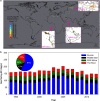A global gas flaring black carbon emission rate dataset from 1994 to 2012
- PMID: 27874852
- PMCID: PMC5127487
- DOI: 10.1038/sdata.2016.104
A global gas flaring black carbon emission rate dataset from 1994 to 2012
Abstract
Global flaring of associated petroleum gas is a potential emission source of particulate matters (PM) and could be notable in some specific regions that are in urgent need of mitigation. PM emitted from gas flaring is mainly in the form of black carbon (BC), which is a strong short-lived climate forcer. However, BC from gas flaring has been neglected in most global/regional emission inventories and is rarely considered in climate modeling. Here we present a global gas flaring BC emission rate dataset for the period 1994-2012 in a machine-readable format. We develop a region-dependent gas flaring BC emission factor database based on the chemical compositions of associated petroleum gas at various oil fields. Gas flaring BC emission rates are estimated using this emission factor database and flaring volumes retrieved from satellite imagery. Evaluation using a chemical transport model suggests that consideration of gas flaring emissions can improve model performance. This dataset will benefit and inform a broad range of research topics, e.g., carbon budget, air quality/climate modeling, and environmental/human exposure.
Conflict of interest statement
The authors declare no competing financial interests.
Figures





References
Data Citations
-
- Huang K., Fu J. S. 2016. Figshare. https://dx.doi.org/10.6084/m9.figshare.c.3269243 - DOI
References
-
- Elvidge C. D., Zhizhin M., Baugh K., Hsu F. C. & Ghosh T. Methods for Global Survey of Natural Gas Flaring from Visible Infrared Imaging Radiometer Suite Data. Energies 9, 14 (2016).
-
- World Bank. Igniting Solutions to Gas Flaring in Russia http://www.worldbank.org/en/news/feature/2013/11/12/igniting-solutions-t..., November 12, 2013 (2013).
-
- Anomohanran O. Determination of greenhouse gas emission resulting from gas flaring activities in Nigeria. Energ. Policy 45, 666–670 (2012).
-
- Ologunorisa T. E. A review of the effects of gas flaring on the Niger Delta environment. Int. J. Sust. Dev. World 8, 249–255 (2001).
-
- Solov'yanov A. Associated petroleum gas flaring: Environmental issues. Russ. J. Gen. Chem. 81, 2531–2541 (2011).
Publication types
LinkOut - more resources
Full Text Sources
Other Literature Sources

